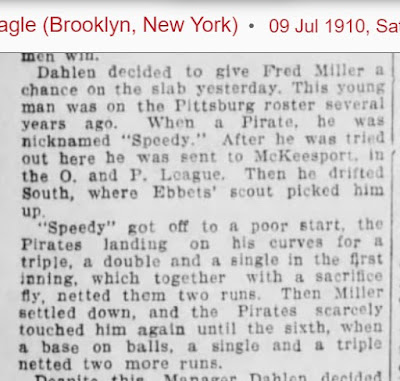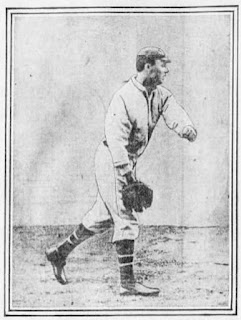 |
| Superbas from 1900 |
A somewhat memorable point occurred in the movie Field of Dreams, where Kevin Costner and James Earl Jones are seen stopping along the highway to pick up a ragtag kid.
The boy identifies himself as Archie Graham and says he's on his way into town to see if he can "play some ball."
Archie is, of course, "Moonlight" Graham.
Graham existed. In the movie, he was Burt Lancaster. In real life, he was a right fielder who played in one big-league game in 1905 before becoming a doctor.
In other baseball news a year later, Fred Miller, a big strapping lefthander from Indiana, found his way to Paducah, where he signed a professional contract to pitch in the Kentucky-Illinois-Tennessee (Kitty) League.
The Kitty was the Class D minors -- if you went lower than that, you weren't a professional. The pay was probably by the game and contingent upon the crowd. They passed the hat.
Fred Miller won 17 games, lost 14, and was as wild as a March hare.
But he threw hard. A lefthander in those days who threw hard probably had a chance to make the majors.
They called him Speedy.
Fred H. (Speedy) Miller was born in 1886 on a farm just south of Fairfield. He died in 1953 and was buried in Maple Grove Cemetery in Brookville. (The farm itself was displaced by the Brookville lake.)
Along the way, Speedy did what no other Fairfielder ever did -- he pitched in the major leagues.
Briefly, although he stuck around a hair longer than Moonlight Graham did.
In 1910, Speedy got his chance to pitch for the Superbas, which was what the team was called long before it became the Dodgers.
Speedy found his way into the professional ranks after success playing high school baseball at Brookville. He was 20 when he signed with Paducah.
I can't determine how he got to Paducah in the first place but the Pirates bought his contract in February 1907. The Pirates at the time evidently saw his future as sterling.
The Pirates sent him to Jackson, Miss., for the 1907 season. He was 9-7 there with almost as many walks (58) as strikeouts (63.) And 1908 appears to be his shining moment -- 18-6 with Jackson, which was in the Cotton States League. (No other stats are available.)
In 1909, Fred was 12-17 with Columbia (239 innings). Miller was at Chattanooga in 1910, drafted by Brooklyn off the Columbia roster in March. From there, he went to 'Nooga. He is not listed on their BBRef roster, but newspaper stories mention his name frequently in game reports.
In May, the Superbas bought his contract. Minor leagues were much different in the ancient days. Players signed contracts with the teams but were not directly linked to big-league rosters unless their new contract included that.
At 6-feet-2 and 190 pounds, Speedy lacked none of the physical tools
to make it big in the majors, although his record suggests
he was a bit too wild to be reliable.
He made his first appearance on July 8, 1910, against Pittsburgh in a game the Superbas won 6-5. The following day, the Superbas went to Cincinnati for a series. He did not pitch in that series, but did appear on July 13 as a reliever in a loss at St. Louis.
Speedy didn't stick with the Superbas, who weren't very good that year. He pitched in 6 games in 1910, winning one, losing one, walking 13, striking out 2 and hitting three batters with errant pitches. His earned run average was 4.71.
His big-league career ended in September 1910 when his contract was sold to Rochester of the Eastern League. Stats do not indicate he ever pitched for that team.
Speedy showed up in 1911 pitching briefly for Sioux City before being released. He then signed with an independent team in Mitchell, SD, and wasn't too effective. The stats are not available for those teams. Sioux City was a Western League team at the time, affiliated with Brooklyn.
Speedy showed up in 1911 pitching briefly for Sioux City before being released. He then signed with an independent team in Mitchell, SD, and wasn't too effective. The stats are not available for those teams. Sioux City was a Western League team at the time, affiliated with Brooklyn.
In 1912, Speedy was 6-6 with Charlotte of the Carolina League and played the following season with a semipro team in Springfield IL.
After that, he went back home and played semipro ball for three years through 1917.

.jpg)


This comment has been removed by a blog administrator.
ReplyDelete